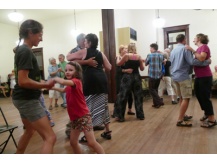
decorahnews.com feature: Foot-Notes celebrate 28 years
Posted: Sun, Aug 11, 2019 5:23 PM
(story by decorahnews.com's Ben Gardner):
Beth Rotto first heard Scandinavian folk music when she happened across a local band playing at the campus café at Luther in the mid-'70s. She was smitten, and when she learned they played Saturday nights outside of town at an old two-room schoolhouse tucked in a shady grove, she couldn't resist. Soon Beth was a regular at Highlandville dances, and, as a violinist, she was drawn to the fiddling of bandleader Bill Sherburne.
A decade later, Beth heard rumors of Bill's retirement from Highlandville dances. Fearing a tradition of Scandinavian folk music would be lost, Beth asked to be his fiddling apprentice. He was cool to the idea; nevertheless, she persisted and drafted a grant that was funded by the Iowa Arts Council. They scheduled ten weekly lessons.
Bill didn't warm to these lessons until Beth started bringing her husband, Jon, who accompanied on guitar. The addition of another set of strings excited Bill, and soon he started taking his apprentice seriously. Recalling this time, Beth says she was a sponge, soaking up all the details of Bill's fiddling. The way his shoulder supported the fiddle, how his fingers deftly held the bow as it cut across the strings. He passed on the repertoire that's been the framework for Highlandville dances: traditional waltz, two-step, polka, and the schottische. Beth began her apprenticeship mimicking his playing, and soon found her own style within his influence.
This style would be imprinted on Foot-Notes, which Beth formed in 1991 with her husband Jon on guitar, Bill Musser on acoustic bass, and Jim Skurdall on mandolin. Foot-Notes began playing the Highlandville dances and other events, and 28 years later, the band is playing tonight, on this blessedly crisp summer evening.
There's a good crowd already dancing and milling around when I arrive after dark at the schoolhouse. Inside the schoolhouse, the walls are lined with long wooden benches and old folding chairs. Suspended overheard are the original glass light fixtures, illuminating the dancers as they trample this century-old hardwood floor. You can't scuff this floor; years of shuffling feet and callused heels have left the wood marbleized.
A lot of people are sitting or standing along the sides, watching, content to observe the kaleidoscope of body shapes moving, thumping, jumping, twirling, waltzing, bumping, and resting. This formal Scandinavian dancing is exhausting; many of these observers are worn out. And so they rest and marvel at the youths who aggressively leap and bound the dance floor.
All manner of dance style is on display. You've got the old guard, who've come to these for decades, stately and formally waltzing. You've got the teenagers—tight shouldered and long limbed—experimenting with dance styles older than this state. Then you've got the young adults and parents of young children, filling out the crowd, adding a frenzied vitality to this humid schoolhouse.
Copyright © - decorahnewsarchive.com. All rights reserved.| Terms Of Use Statement.

Site designed and maintained by Iroc Web Design Services©.
Your Small Business Web Design Solutions.™
Site designed and maintained by Iroc Web Design Services©.
Your Small Business Web Design Solutions.™




